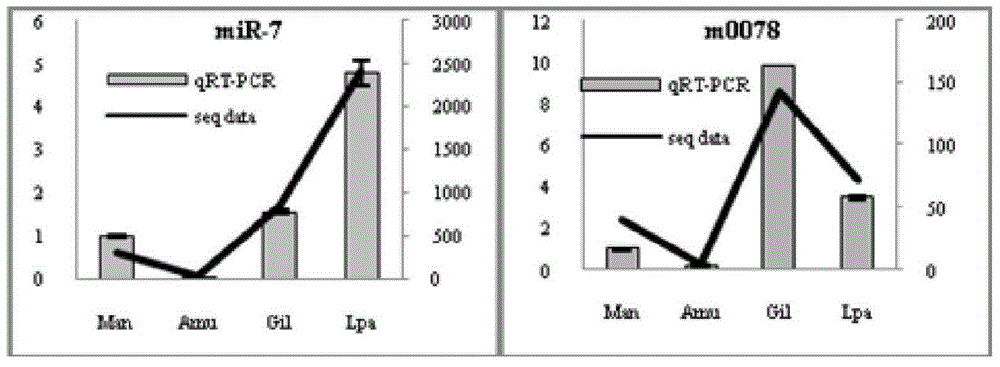Application of a dual-gene microRNA fluorescence quantitative internal reference and its primers in shellfish tissue samples
A fluorescence quantitative and tissue sample technology, applied in the field of molecular biology, can solve the problems of high cost and unsuitability for miRNA function analysis, and achieve the effect of low cost, high sensitivity and improved accuracy
- Summary
- Abstract
- Description
- Claims
- Application Information
AI Technical Summary
Problems solved by technology
Method used
Image
Examples
Embodiment 1
[0043] Selection of candidate internal reference genes: We performed microRNA sequencing on different tissue samples of oyster oyster, and obtained some newly identified microRNAs and their expression profiles. Based on the miRNA expression profiling data, we selected five microRNAs with relatively stable expression as candidate genes (ie, let-7, miR-87, miR-1994, miR-71, miR-1). At the same time, the commonly used microRNA internal reference gene 5.8S RNA, snRNA U6 and snRNA U1 were used as candidate genes.
[0044] The miRNA sequence (see Table 1) and sequencing expression profile of Oyster oyster are the results given by the RNA samples provided by us and sequenced and analyzed by Shenzhen BGI Institute. The following is a brief introduction to the method of deep sequencing analysis. For details, please refer to the literature [Huang J, Hao P, Chen H, HuW, Yan Q, et al. (2009) Genome-wide identification of Schistosoma japonicum microRNAs using a deep-sequencing approach. P...
Embodiment 2
[0048] Evaluate the expression stability of candidate internal reference genes by fluorescent quantitative PCR: design specific primers according to the candidate gene sequence, perform fluorescent quantitative PCR in tissue samples, and obtain the expression data of each candidate gene in each tissue—Ct value (threshold cycle, per The number of cycles experienced when the fluorescent signal in a reaction tube reaches the set threshold value). Use the Ct value data with Equation 2 -Ct After conversion, use the most commonly used excel algorithm NormFinder for internal reference screening to calculate the stable value of each candidate gene. The smaller the stable value, the more stable the gene expression. For the specific algorithm and principle of NormFinder, please refer to the literature [ANDERSEN, C.L., JENSEN, J.L.&ORNTOFT, T.F.2004 Normalization of real-time quantitative reverse transcription-PCR data: A model-based variance estimation approach to identify genes suited ...
Embodiment 3
[0067] The double-gene combination is used as an internal reference, and the expression level Ct value of the double-gene internal control is the arithmetic mean of the expression level Ct values of the let-7 and miR-87 genes in a certain tissue sample. Using the method based on SYBR Green dye-based fluorescent quantitative PCR, the relative quantitative analysis of two randomly selected long oyster miRNAs (miR-7 and m0078) in four tissues (mantle, adductor muscle, gills, and lip flaps) was carried out. See literature: [Shi R, Chiang VL (2005) Facile means for quantifying microRNA expression by real-time PCR. Biotechniques 2550 39: 519-525.]. It was found that the results of fluorescent quantitative PCR using the double gene as an internal reference were highly consistent with the results of the sequencing expression profile, which proved the reliability and stability of the dual gene internal reference.
[0068] Relative quantification of long oyster miRNA:
[0069] Obtain...
PUM
 Login to View More
Login to View More Abstract
Description
Claims
Application Information
 Login to View More
Login to View More - R&D
- Intellectual Property
- Life Sciences
- Materials
- Tech Scout
- Unparalleled Data Quality
- Higher Quality Content
- 60% Fewer Hallucinations
Browse by: Latest US Patents, China's latest patents, Technical Efficacy Thesaurus, Application Domain, Technology Topic, Popular Technical Reports.
© 2025 PatSnap. All rights reserved.Legal|Privacy policy|Modern Slavery Act Transparency Statement|Sitemap|About US| Contact US: help@patsnap.com



